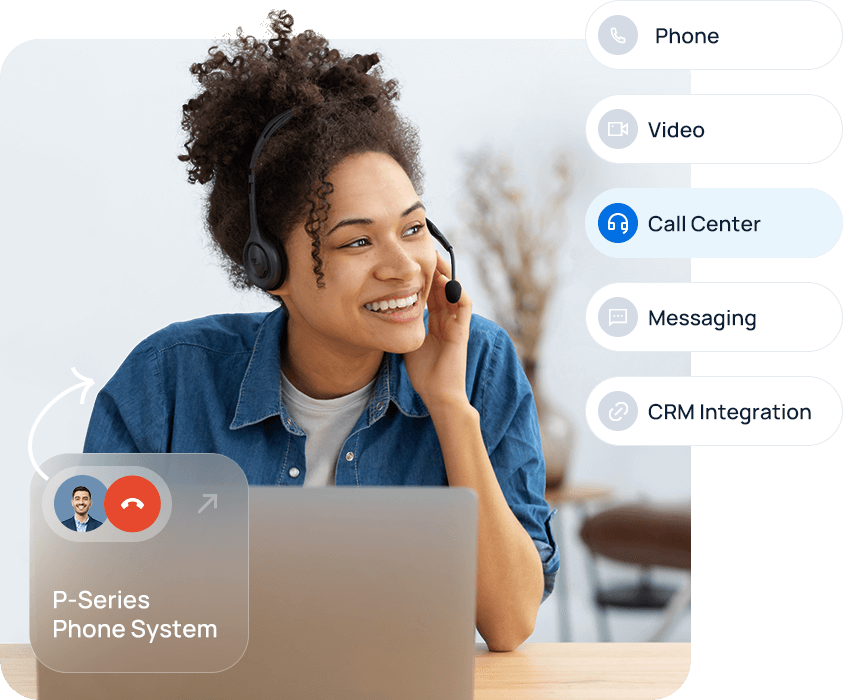
What is Yeastar
Call Center Solution?
The Yeastar P-Series Phone System has a built-in call center solution. This solution offers businesses a comprehensive package for calls, video, messaging, integrations, and more. It is suitable for businesses of all sizes.
With the all-in-one solution, you can cut down call resolution time, decrease employee workload, and transform customer experiences through intelligent call routing, unified agent tools, and insights & analytics. Also, forget per agent per month pricing. The features are available to all system users.
Better Customer Service with Call Center PBX

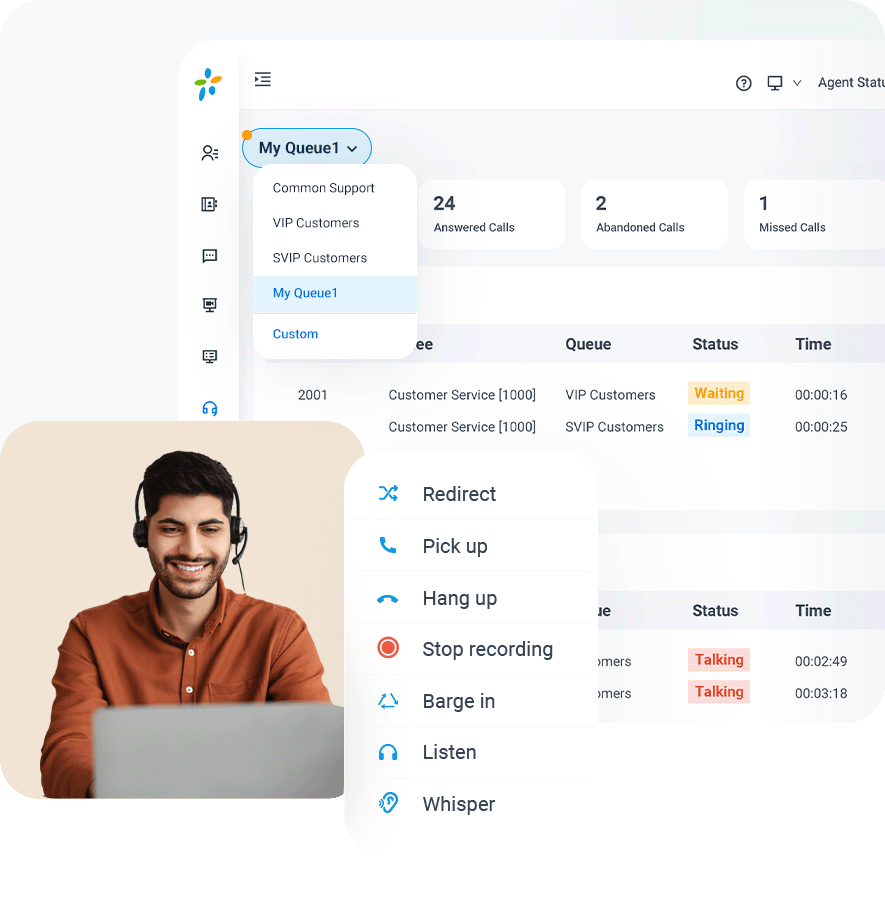
Unified Agent and Supervisor Workspace
Provide all the tools your agents and supervisors need in one single web-based interface. The intuitive Queue Panel allows you to monitor queue traffic, check & switch agent status, and quickly conduct call operations like transfer, monitor, and parking with simple clicks.
Active & waiting call activities in one view
Drag & drop call management
Complete view of agent availability & performance data
Real-time queue performance metrics tracking and display at individual, group or aggregated level
Role-based feature access control
Real-time Performance Tracking
Discover up-to-the-minute call center metrics and key performance indicators (KPIs) from the central call center Wallboard. All data are automatically calculated in real-time, daily, weekly, or monthly intervals for your in-depth call center monitoring, management & optimization.
Track sum of all queues or
statistics of individual queue
17 Key Performance Metrics
Real-time Monitoring
Flexible Calculation Time Frame
Customizable Widgets
Multi-screen Display
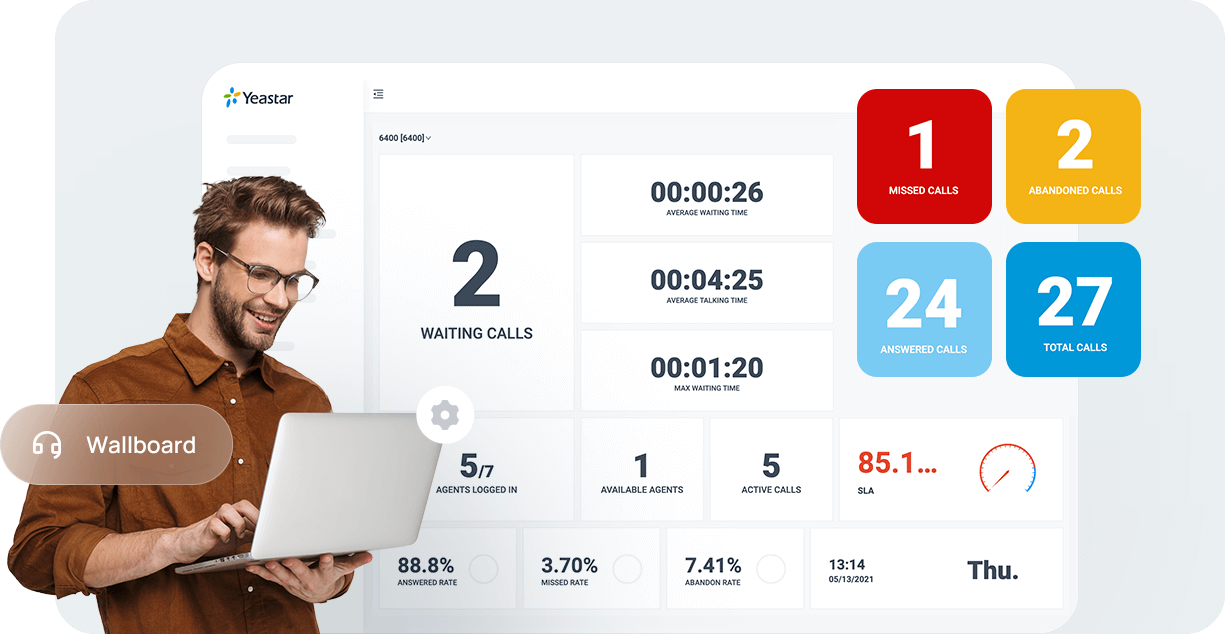
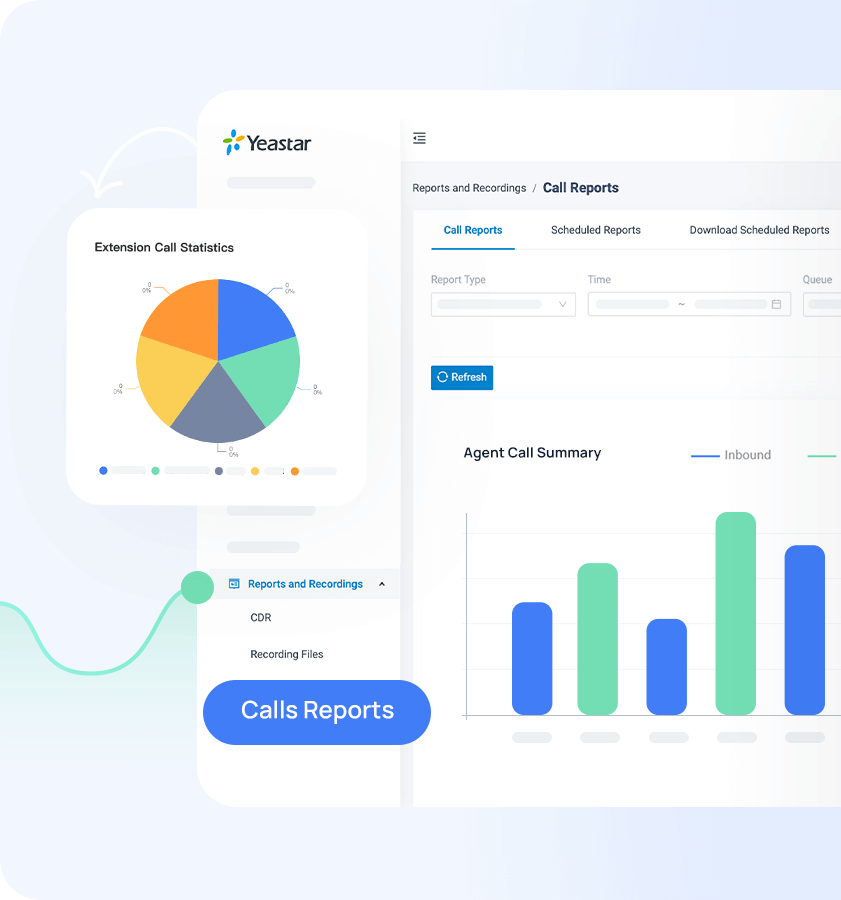
Intuitive Reports,
Easier Management
Get access to 8 advanced call center reports. Easily spot issues and opportunities in your call center with comprehensive view of agent-specific operational metrics, call parameters, and panoramic queue statistics.
You can run targeted analysis of your call center data by customizing timeframe, agent, or queue selection. Share the real-time or historical reports with your team in graphical, downloadable formats, and schedule reports to be run periodically in the future.
More for greater customer experience
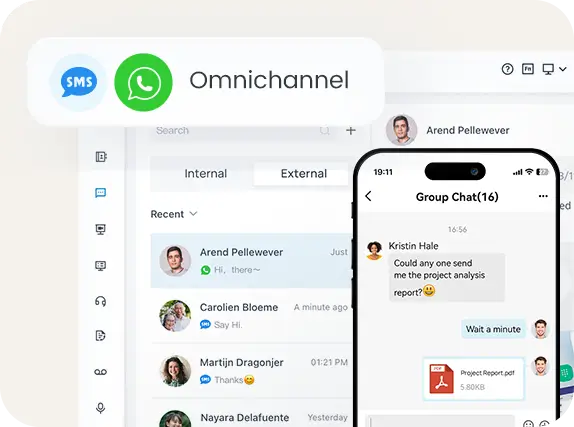
Omnichannel Messaging
Provide customers more ways to get in touch with live chat and integration with WhatsApp, Facebook, and SMS. Access and repond to messages from multiple channels in one place.
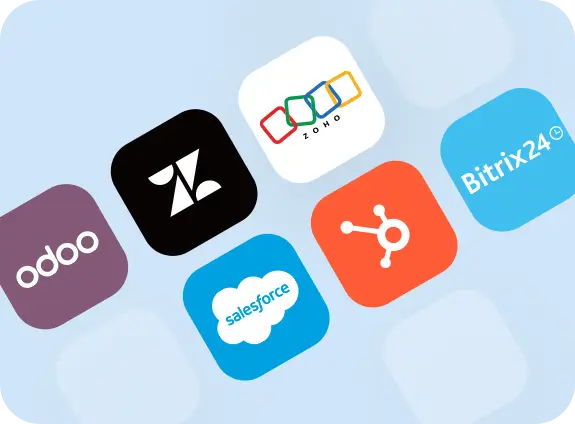
CRM Integration
Rich ready-made CRM/helpdesk integrations to automate repetitive tasks, keep a central record of customer interactions, and elevate agent productivity.
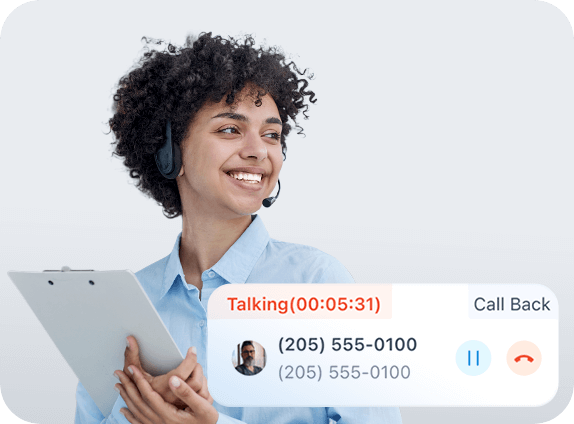
Outbound Call Center
Maximize your proactive outreach by running outbound call campaigns. Enable dialing automation, improve connect rates, and create more revenue opportunities.
All-inclusive Inbound Call Center Features
Automatic Call Distribution (ACD)
Interactive Voice Response (IVR)
Queue Call Logs
Missed Call Disposition
Queue Manager
Dynamic & Statistic Agents
Three-way Calling
Queue Position Annoucement
Estimated Wait Time Accouncement
Wallboard & Real-time Analytics
Post-Call Surveys
Agent Peformance Reports
Queue Performance Reports
Satisfaction Survey Report
Helpdesk Integration
Omnichannel Suppport
Voicemail Transcription
Ready to enjoy the service?
Access all the features in no time with 30-day free trial of Yeastar P-Series Phone System.
Contact us today to get more information
Common FAQs about Call Center Solutions
What is a call center software?
.
Call center software is a technology solution that helps businesses efficiently handle a large number of incoming and outgoing calls, connecting customers with agents. It offers a user-friendly visual workspace with intelligent features that streamline all inbound activities.
In today’s cloud-based call centers, Voice over Internet Protocol (VoIP) systems are commonly used to make VoIP calls. Yeastar’s call center solution offers more than just voice routing and management. It also includes omnichannel messaging support to provide a customer-focused approach. This enhances communication across various digital channels.
How do call center solutions work?
.
A call center PBX is a central system that handles incoming and outgoing calls in a call center. It uses VoIP technology to transmit calls over the internet to different devices.
To ensure efficient call handling, call centers utilize self-service IVR (Interactive Voice Response) and automatic call distribution (ACD). These features route calls to agents based on factors like priority, agent skills, and time of day, improving first-call resolution rates.
Administrators can monitor queue performance through the intuitive Queue Panel feature. Additionally, Yeastar’s call center solution offers a Wallboard that aggregates key performance indicators (KPIs) and metrics for better visibility.
Basic call center software saves customer info and call logs. Advanced systems like Yeastar can connect with CRM or helpdesk platforms. This integration enables agents to access customer contact records before answering each call, improving customer service.
Yeastar’s call center PBX improves customer service with smart call routing, easy management, detailed reports, and seamless integration.
How many types of call center solutions are there?
.
When it comes to call center solutions, there are various types available to meet different business needs. Let’s explore the main categories:
Regarding customer service:
- Inbound Call Center: It handles incoming calls from customers who have inquiries, require assistance, or need support. They work on giving great customer service and use VoIP or other software to handle a lot of incoming calls effectively. The primary objective is to ensure customer satisfaction by promptly and effectively addressing their needs.
- Outbound Call Center: Make proactive outgoing calls to prospective customers. Often associated with a company’s sales department, they aim to sell products or services. Predictive dialers automate outgoing calls, optimizing agent productivity. The primary goals include lead generation, sales closure, and revenue targets.
Regarding deployment options:
- On-Premises Call Center: Companies set up the necessary hardware and software infrastructure within their premises, allowing direct control. However, this option requires substantial upfront investments and ongoing maintenance.
- Hosted Call Center: Infrastructure is provided by a third-party provider, managed off-site. Companies pay a subscription fee for using the hosted solution, eliminating the need to manage underlying technology.
- Cloud-Based Call Center: Utilizing cloud infrastructure, these solutions offer flexibility, scalability, and accessibility from anywhere with an internet connection. Businesses pay for the services they use on a subscription basis, reducing upfront costs and providing easy scalability.
Businesses should choose the appropriate call center solution based on their specific requirements, customer service focus, and preferred deployment method. Each type has its advantages and considerations, so evaluating organizational needs and priorities is crucial before making a
decision.
Does my business need a call center PBX?
.
Determining whether your business needs a call center PBX depends on various factors. Here are some considerations to help you assess the need for a call center PBX:
- High Call Volume. If your business receives many calls, a call center PBX can efficiently handle and direct incoming calls. This reduces customer wait times and ensures prompt assistance.
- Complex Calls. If your business deals with complicated customer inquiries or needs specialized routing based on skills or departments, a call center PBX can intelligently route calls to connect callers with the most suitable agents.
- Agent Collaboration. A call center PBX helps businesses communicate internally during customer interactions with features like internal calling, conferencing, and messaging. These tools enhance teamwork and streamline communication.
- Scalability. If your business plans to grow or expects changes in call volume, a flexible call center PBX system can adjust easily. It can meet your needs without the need for big infrastructure changes.
- Customer Service Improvement. If you need to provide great customer service, a call center PBX can help with call recording, monitoring, and analytics. These tools track performance, identify areas for improvement, and ensure consistent service quality.
- Cost Considerations: Evaluate the costs associated with implementing and maintaining a call center PBX. Assess whether the benefits outweigh the expenses and if the system aligns with your budget and long-term goals.
What are the top call center PBX features?
.
- Automatic Call Distribution (ACD): Route incoming calls to the most appropriate agent or department based on predefined criteria such as skills, availability, or priority.
- Interactive Voice Response (IVR): Allow callers to navigate through menus and make selections using keypad inputs or voice commands. It provides self-service options, gathers initial information, and can route calls to the appropriate department or agent.
- Call Queue: When all agents are busy, calls are placed in a queue with estimated wait times provided to callers. Call queuing ensures fair handling of calls and improves customer satisfaction by managing expectations during peak call periods.
- Service Level Agreement (SLA): It helps you set goals for response time or resolution time and track if they are being met. It helps ensure high service quality and customer satisfaction.
- Queue Panel: Provide real-time visibility into the status of queues, including the number of calls waiting, average wait time, and agent availability. Supervisors can use this feature to monitor queues and make informed decisions for efficient call routing.
- Wallboard: A big screen that shows real-time call center metrics and performance data to both agents and supervisors. It visually represents important information such as call volume, wait times, and agent performance.
- Call Reports: 13 customizable reports to gain the business insights needed to maximize agent performance and provide better customer service and run targeted analysis over your call center data.
- CRM Integration: Access customer information, purchase history, previous interactions, and notes during calls. This integration enhances personalization and enables agents to provide a more personalized and efficient service.
How can I solve call center problems?
.
To solve call center problems, follow these simplified steps:
- Identify and prioritize the issues affecting your call center.
- Analyze the root causes of the problems.
- Develop practical solutions to address the issues.
- Implement the proposed improvements effectively.
- Monitor progress using key performance indicators.
- Provide ongoing training and support for agents.
- Encourage open communication and collaboration.
- Stay updated with industry best practices.
By following these steps, you can systematically address call center problems and improve overall performance.
How to set up a call center in Yeastar phone system?
.
To set up a call center, start by selecting the type of phone system for your business. This will help you decide on the right call center software to install.
If you choose the Yeastar VoIP phone system, it offers all deployment options. Our PBX has a built-in call center software with all the powerful features you need. Before using it, follow these four steps to set up the call center:
- Create a Queue
- Assign Agent Members
- Set up SLA Time
- Set up Operations Availability
What is the difference between a call center and a contact center?
.
Call centers and contact centers have different approaches to delivering customer service. It is important for decision-makers to understand these differences in order to determine the best fit for their business goals.
Call Center:
- Focus: Call centers primarily focus on phone-based customer service, handling both inbound and outbound calls.
- Channels: The main communication channel in call centers is voice-based, with telephone interactions being the primary mode of communication.
- Service Scope: Call centers generally center around customer service, support, and issue resolution over the phone.
- Technology: Call centers typically utilize telephony systems and related infrastructure to handle voice interactions efficiently.
Contact Center:
- Focus: Contact centers provide a broader range of communication channels beyond just voice-based interactions. They aim to cater to customers through multiple channels.
- Channels: Contact centers handle various communication channels, including phone calls, emails, live chat, SMS texting, social media, and more.
- Omnichannel Support: Contact centers strive to offer a consistent and integrated customer experience across all channels. They focus on ensuring smooth transitions between channels and enabling agents to access customer information and interaction history regardless
of the channel used. - Customer Engagement: Contact centers prioritize engaging customers through their preferred channels and accommodating changing consumer preferences.
- Service Offerings: In addition to customer service and support, contact centers may extend their services to include sales, marketing, self-service options, and proactive outreach through various channels.
Understanding these distinctions between call centers and contact centers will help businesses determine which approach aligns better with their specific needs and objectives.
X
